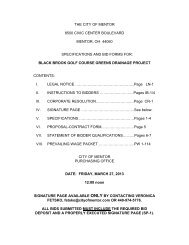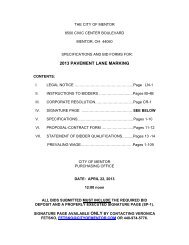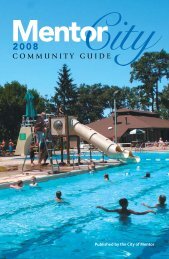Storm Water Pollution Prevention Plan (SWP3)
Storm Water Pollution Prevention Plan (SWP3)
Storm Water Pollution Prevention Plan (SWP3)
You also want an ePaper? Increase the reach of your titles
YUMPU automatically turns print PDFs into web optimized ePapers that Google loves.
Construction Site <strong>SWP3</strong> Checklist<br />
Page 8 of 14<br />
For construction activities that are on the stream bank or will involve stream crossing, does<br />
the <strong>SWP3</strong> include measures to minimize the number of stream crossings and/or the width<br />
of disturbance? NOTE: If work along a stream bank is necessary, a non-erodible pad or<br />
non-erodible stream diversion dams (sand bags) must be installed. If stream crossings are<br />
necessary, a non-erodible stream crossing must be installed.<br />
‘ YES<br />
‘ NO<br />
Does the <strong>SWP3</strong> include the installation of a structural post-construction best management practice (BMP)<br />
to manage storm water runoff once construction activities have been completed?<br />
‘ YES<br />
‘ NO<br />
Has a long-term maintenance plan been developed or included in the <strong>SWP3</strong> for maintenance of the structural<br />
post-construction BMP? NOTE: The long-term maintenance plan must be developed and provided to the<br />
post-construction site operator, but does not need to be implemented as required by this permit. Local<br />
municipalities may require maintenance plan implementation.<br />
‘ YES<br />
‘ NO<br />
Is the construction activity a linear project (e.g., pipeline or utility line installation) that does not result in<br />
the installation of impervious surface? NOTE: Linear projects that don’t result in the installation of<br />
impervious surface do not need the installation of structural post-construction BMPs.<br />
‘ YES<br />
‘ NO<br />
Large Construction Activities (5 acres and up)<br />
Does the <strong>SWP3</strong> include a structural post-construction BMP with a specified volume and drain time?<br />
‘ YES<br />
‘ NO<br />
If so, was one of the two methods proposed in the NPDES construction storm water general permit (CGP)<br />
used to determine the water quality volume (WQ v) and drain time?<br />
‘ YES<br />
‘ NO<br />
If the formula described in the CGP was used to calculate the WQ v, were the correct values used for:<br />
(a) runoff coefficient (C)? ‘ YES ‘ NO<br />
(b) precipitation depth (P = 0.75-inches)? ‘ YES ‘ NO<br />
(c) and the drainage area (A) to the BMP? ‘ YES ‘ NO
















